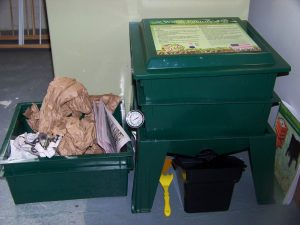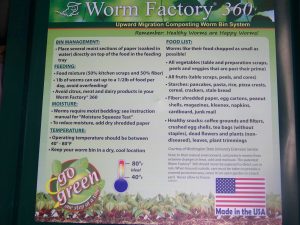
A couple of posts ago, you read about my new experiment in home vermicomposting. But since then I’ve learned there’s definitely a right way and a wrong way to go about it. Basically, I now wish I’d started with one of these pictured here — a Worm Factory 360 — from the beginning rather than my original solid plastic tub. I’m sure there are other setups that would work as well — not every successful vermicomposter I know has a Worm Factory — but I’ve learned the hard way that you’ve got to manage moisture properly, or you will get not only a bad smell and gloppy vegetable garbage in your bin but really stressed and frantic — even dead — worms. It’s never a good feeling to be an instrument of damage to a living thing in your care, no matter whether it’s furry or it’s green or it’s got porous skin and an aversion to light and an extremely simple digestive system.
All went well with my first little setup — the plastic bin pictured in the previous post — until about a week or so after I first added my new worms. When I went down to the basement and lifted the lid, an earthworm literally launched itself off the edge. (“Cry for help” was kind of the unmistakable conclusion.) The worms seemed to have been reproducing (there were little babies all the way through) but overall something was not right. The adults were clumped together in knots on top of the food or straining up the sides of the bin into the crevices of the lid. The reason: moisture accumulating in the bottom as the produce I had been zealously (over)feeding them released its water. I hadn’t punched any holes in the tub for drainage, hoping to be able to use it for other things and not realizing how much water would accumulate, and so my worms were in danger of drowning.
Draining off smelly brown water from a badly managed home vermicomposting bin is not a pleasant way to spend an evening. Luckily, my plants seemed to benefit from a drink of that water. And with the arrival of the Worm Factory (“hold on, y’all!” I found myself whispering encouragingly as I passed the bin, “UPS tracking says only one more day to go!”) things began to look up for the worms and for me. Once I set up the WF and mixed in the proper amounts of paper (to absorb moisture) with the existing compost material in which the worms had been working, the smell was gone within a day.
Whether the worms would recover, though, seemed in doubt. A lot of them had drowned without my realizing it, and a peek into the innards of the WF a couple days after its installation revealed a sobering lack of worm activity. Like I said: it’s not a good feeling knowing you have killed helpless things that were relying on you. However, twelve days later after installing them in their new home, the worms seem to have rebounded; I can see many more of them now, and the moisture problems are cured. This has been a chance to be grateful, again, for the particular elasticity and forgiveness of nature; do your best to treat it right and give it a chance to heal, and it probably will.
What did I do wrong? First of all, I definitely did not have enough drainage in my bin, and I didn’t mix in enough shredded paper to help absorb and regulate the moisture, so the water released by the decomposing vegetables had nowhere to go — and the worms had nowhere to go to escape the rising flood (you want moist, not sodden). Similarly, although I had never sealed the bin airtight, I didn’t have enough air circulation. And I was overfeeding; I now think that while worms can get through quite a bit of kitchen waste, they may not be able to take every single bit of compostable material your kitchen produces every day. They definitely couldn’t take — on top of what I had given them that day, and the day before, and the day before — a giant heirloom squash that was part of my friend’s downtown shop window display, and that had begun to develop a bad spot. “I’ll take that off your hands!” I chirped, and so I happily toted the spongy squash home in a bag. It went straight into the worm bin. I’d still take that squash home now – but I’d take it out back to my compost pile. Maybe this is the ultimate takeaway point: home vermicomposting is great, but it needs to work in tandem with a backyard compost pile as well.

I loved reading this sentence as a preface to a tale about vermiculture: “But since then I’ve learned there’s definitely a right way and a wrong way to go about it.” I knew something harrowing was coming my way, and as always when reading CI, was not disappointed.
ha ha ha! “harrowing….” suitable verb for a post about worms! no wonder you are an english professor! 🙂
“When I went down to the basement and lifted the lid, an earthworm literally launched itself off the edge.”
hee hee… yep, i could practically hear it shrieking. or, actually, that was me. before i could stop myself, i did kind of… shriek. “AAAAH!” kind of hard not to when a worm leaps out at you, determined to sacrifice itself for the greater good of awareness of the plight of the many… i shouldn’t joke about it, but hey, it worked.